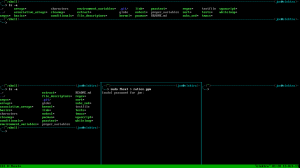4:3 / 16:9
by debianjoe
This is another topic that can cause a minor schism in how we as users perceive what is “best.” Essentially, it comes down to how the system will be used as to what is the best possible answer is. I’m going to restrict myself to only discussing laptops, as external monitors allow a wide array of answers to some of these issues.
As for myself, I keep two laptops that I regularly use. One is a Toshiba Satellite (loaded with LinuxBBQ Elektra, Tiny, and Debian Sid), and the other is the aforementioned Thinkpad T43 (LinuxBBQ tiny). The Toshiba is WXGA (1366×768) which has an aspect ratio of 16:9, while the T43 uses SXGA (1400×1050) which is a ratio of 4:3, and is also usable as 1024×768 XGA (the most common variation of 4:3 screens.)
While it’s generally easier to say that ‘more pixels == better’, we’ll look at this from the more practical stance of “What is best suited for my purpose?” If you’re going to use the laptop to view high-definition movies, then 16:9 is the most practical answer. It’s the standard now for cinematic layouts. Most games and movies are being created now to cater to this format, and thus, you’ll have to letterbox the screen on the 4:3 monitors.
The argument for 4:3 starts with the purpose that laptops weren’t really designed to be “portable DVD players”, but rather tools for working away from your normal desktop. They were designed to be a lightweight computer that would be easily portable. With that in mind, let’s take two theoretical laptops that both have 15″ screens…and examine the total screen space differences between the two resolutions. If a screen’s measurements are determined by the horizontal line (hypotenuse) of the right triangle that extends from one corner to the other, then the total area can be found by pretty basic geometry. Let’s call the diagonal measurement of the screen “d” and the ratio “r”. So, our formula for figuring out height, width, or area should all be related:
Since we’re dealing with computers anyhow, let’s set this up as a linear equation. For our 15″ 4:3 screen, we can determine area with 15**2 / ((4/3) + (3/4)) while our 16:9 screen should be 15**2 / ((16/9) + (9/16))…or in lisp (/ (* 15.0 15.0) (+ (/ 4.0 3.0) (/ 3.0 4.0))) and (/ (* 15.0 15.0) (+ (/ 16.0 9.0) (/ 9.0 16.0))). (*note: I prefer to use lisp for complex equations. Specifically the scheme dialect of lisp is very well suited for this task.)
What we find is that the 4:3 screen has a total area of approximately 108 inches, whereas the 16:9 screen is closer to 96 inches. As 96 is only about 88.8+% of 108, we can safely assume that the 4:3 screen has about 12% more total area than the 16:9 would. If you look carefully at our equation, the closer to a perfect square we come, the larger the total area. Thus, it stands to reason that the better of the two layouts if you’re looking to keep the size of the screen small would be the one that most resembled a square.
The other major area of discussion is with programmers and coders. Generally from what I personally feel, and what many others have said, vertical space is more useful than horizontal space. The reason that we don’t write C in one long, continuous line is that it makes it very difficult to read. It’s why most lisp utilizes “pretty printing”, and why the pep-8 standard for python requires that lines be 79 characters or less. Let’s create an example with python to print out a series of 10 lines of “#” marks that are exactly 79 characters long. In order to take into consideration the obvious “I split the screen in half while programming” counter argument, I’ll use two panes in tmux and run this script on both sides.
It’s pretty easy to see that there is a good portion of space wasted on each side of the blocks of text when the suggested coding standards are followed on a 16:9 screen with what I’d consider a reasonably sized font. 4:3 does not waste as much space for the same procedure, while it manages to provide more vertical space without having to change the font size.
Once again, like all things that are heavily debated in the world of technology, Unix, and programming…it really comes down to filling a personal need. If you’re watching movies, then 16:9 makes sense. If you’re programming or simply trying to get as much screen real estate as possible, then 4:3 is superior.
If you have obsessive compulsive disorder, then consider that ‘phi’ (the Greek letter) is related most closely to a screen ratio of 16:10, as (a+b is to a as a is to b) where we’re looking at height/width. This is often referred to as The Golden Ratio, and while perhaps not the most efficient layout, it does stand to reason to be the one most related to mathematical perfection.

